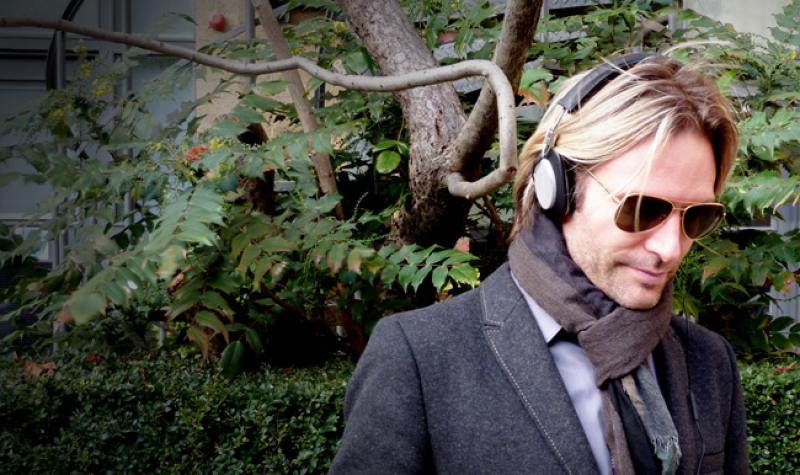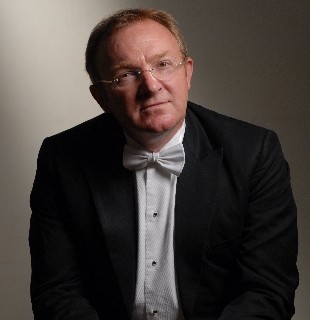BBC Proms: BBCSO, Brabbins/Eric Whitacre Singers, Heap, Whitacre | reviews, news & interviews
BBC Proms: BBCSO, Brabbins/Eric Whitacre Singers, Heap, Whitacre
BBC Proms: BBCSO, Brabbins/Eric Whitacre Singers, Heap, Whitacre
An evening of English classics and a choral superstar

Eric Whitacre – less a composer or conductor, more a global choral phenomenon. Just the mention of his name in last night’s concert introduction drew whoops and wolf-whistles from the crowd, certainly not a reaction you tend to get for Beethoven, Boulez or Cage (though perhaps the latter gets a silent cheer).
Making his Proms debut with the Eric Whitacre Singers (a dream team of London’s freelancers) and the BBC Singers, with a little help from Ensemble Bash and soprano Hila Plitmann, Whitacre framed his own works within other staples of the American choral tradition. Hogan’s vibrant trio of spiritual arrangements showcased the low basses, and Bernstein’s throwaway Warm-Up established the ensemble’s athletic credentials from the off.
Vintage Whitacre – diaphanous cluster chords and foaming soundscapes
The influence of Bernstein’s scat-inspired textures had distant echoes in Whitacre’s new BBC Commission Higher; Faster; Stronger which unusually brought rhythm rather than harmony to the fore. Playing musically with the Olympic-themed idea of a race, though efficient and deft in its textural manipulations, it would have been interesting to see its central idea extended even further. Whitacre classic Leonardo Dreams of His Flying Machine (immaculately handled by the singers) reminded us of what this composer is capable of when completely committed musically to an image or theme, and I’d love to have seen this same ambition echoed elsewhere.
 The evening’s other world premiere – Imogen Heap’s The Listening Chair (Heap pictured right) – combined physical percussion and Heap’s own vocals with backing from Whitacre’s choirs. Long on concept, short on coherence, the work took longer to explain than perform, and it’s intimate, confessional content and magpie styles didn’t quite translate in the unforgiving Royal Albert Hall.
The evening’s other world premiere – Imogen Heap’s The Listening Chair (Heap pictured right) – combined physical percussion and Heap’s own vocals with backing from Whitacre’s choirs. Long on concept, short on coherence, the work took longer to explain than perform, and it’s intimate, confessional content and magpie styles didn’t quite translate in the unforgiving Royal Albert Hall.
We finished the evening with vintage Whitacre – the diaphanous cluster chords and foaming soundscapes of Cloudburst and Sleep. Passing a delicate finger-clicking from the stage out into the audience Whitacre magically summoned the rainstorm, the soft plash of droplets echoing on all sides. The harmonic and textural gestures of this work are no less evocative or precise, and with the Eric Whitacre Singers setting the character of the choral blend we were guided expertly through this musical scene.

Martyn Brabbins’ tempos kept things brisk and the right side of sentimental, letting Miah Persson’s understated soprano do the emoting (Brabbins pictured left). Andrew Kennedy’s tenor solo fared less well, more often set up to fail in competition with full choral might, and struggling a little with the crucial legato. Lively with triplets and notes tied over the barline, Howells is all about ebb and expressive freedom. Despite Brabbins’ understanding of this repertoire the chorus felt a little unwilling to release, not quite gelling as an ensemble and feeling a little stiff in all but the most euphoric of climaxes.
Given the sleeker forces of the BBCSO, Brabbins was able to shape Elgar’s First Symphony much more fluidly in the second half. Pace again was brisk without feeling rushed, but generating an organic sense of development and flow between sections. The opening string cantilena was warmly sung, restrained enough to give the orchestra somewhere to grow to over the next hour, and grow they did. The brass contributed some fantastically grotesque colours for the scherzo, and the whole symphony had a natural shape that kept the overarching journey in mind while never losing the drama of the miniature moments.
Explore topics
Share this article
The future of Arts Journalism
You can stop theartsdesk.com closing!
We urgently need financing to survive. Our fundraising drive has thus far raised £49,000 but we need to reach £100,000 or we will be forced to close. Please contribute here: https://gofund.me/c3f6033d
And if you can forward this information to anyone who might assist, we’d be grateful.

Subscribe to theartsdesk.com
Thank you for continuing to read our work on theartsdesk.com. For unlimited access to every article in its entirety, including our archive of more than 15,000 pieces, we're asking for £5 per month or £40 per year. We feel it's a very good deal, and hope you do too.
To take a subscription now simply click here.
And if you're looking for that extra gift for a friend or family member, why not treat them to a theartsdesk.com gift subscription?
more Classical music
 Bizet in 150th anniversary year: rich and rare French offerings from Palazzetto Bru Zane
Specialists in French romantic music unveil a treasure trove both live and on disc
Bizet in 150th anniversary year: rich and rare French offerings from Palazzetto Bru Zane
Specialists in French romantic music unveil a treasure trove both live and on disc
 Scottish Chamber Orchestra, Ibragimova, Queen’s Hall, Edinburgh review - rarities, novelties and drumrolls
A pity the SCO didn't pick a better showcase for a shining guest artist
Scottish Chamber Orchestra, Ibragimova, Queen’s Hall, Edinburgh review - rarities, novelties and drumrolls
A pity the SCO didn't pick a better showcase for a shining guest artist
 Kilsby, Parkes, Sinfonia of London, Wilson, Barbican review - string things zing and sing in expert hands
British masterpieces for strings plus other-worldly tenor and horn - and a muscular rarity
Kilsby, Parkes, Sinfonia of London, Wilson, Barbican review - string things zing and sing in expert hands
British masterpieces for strings plus other-worldly tenor and horn - and a muscular rarity
 From Historical to Hip-Hop, Classically Black Music Festival, Kings Place review - a cluster of impressive stars for the future
From quasi-Mozartian elegance to the gritty humour of a kitchen inspection
From Historical to Hip-Hop, Classically Black Music Festival, Kings Place review - a cluster of impressive stars for the future
From quasi-Mozartian elegance to the gritty humour of a kitchen inspection
 Shibe, LSO, Adès, Barbican review - gaudy and glorious new music alongside serene Sibelius
Adès’s passion makes persuasive case for the music he loves, both new and old
Shibe, LSO, Adès, Barbican review - gaudy and glorious new music alongside serene Sibelius
Adès’s passion makes persuasive case for the music he loves, both new and old
 Anja Mittermüller, Richard Fu, Wigmore Hall review - a glorious hall debut
The Austrian mezzo shines - at the age of 22
Anja Mittermüller, Richard Fu, Wigmore Hall review - a glorious hall debut
The Austrian mezzo shines - at the age of 22
 First Person: clarinettist Oliver Pashley on the new horizons of The Hermes Experiment's latest album
Compositions by members of this unusual quartet feature for the first time
First Person: clarinettist Oliver Pashley on the new horizons of The Hermes Experiment's latest album
Compositions by members of this unusual quartet feature for the first time
 Gesualdo Passione, Les Arts Florissants, Amala Dior Company, Barbican review - inspired collaboration excavates the music's humanity
At times it was like watching an anarchic religious procession
Gesualdo Passione, Les Arts Florissants, Amala Dior Company, Barbican review - inspired collaboration excavates the music's humanity
At times it was like watching an anarchic religious procession
 Classical CDs: Camels, concrete and cabaret
An influential American composer's 90th birthday box, plus British piano concertos and a father-and-son duo
Classical CDs: Camels, concrete and cabaret
An influential American composer's 90th birthday box, plus British piano concertos and a father-and-son duo
 Cockerham, Manchester Camerata, Sheen, Martin Harris Centre, Manchester review - re-enacting the dawn of modernism
Two UK premieres added to three miniatures from a seminal event of January 1914
Cockerham, Manchester Camerata, Sheen, Martin Harris Centre, Manchester review - re-enacting the dawn of modernism
Two UK premieres added to three miniatures from a seminal event of January 1914
 Kempf, Brno Philharmonic, Davies, Bridgewater Hall, Manchester review - European tradition meets American jazz
Bouncing Czechs enjoy their Gershwin and Brubeck alongside Janáček and Dvořák
Kempf, Brno Philharmonic, Davies, Bridgewater Hall, Manchester review - European tradition meets American jazz
Bouncing Czechs enjoy their Gershwin and Brubeck alongside Janáček and Dvořák
 Solomon, OAE, Butt, QEH review - daft Biblical whitewashing with great choruses
Even a top soprano and mezzo can’t make this Handel paean wholly convincing
Solomon, OAE, Butt, QEH review - daft Biblical whitewashing with great choruses
Even a top soprano and mezzo can’t make this Handel paean wholly convincing

Add comment